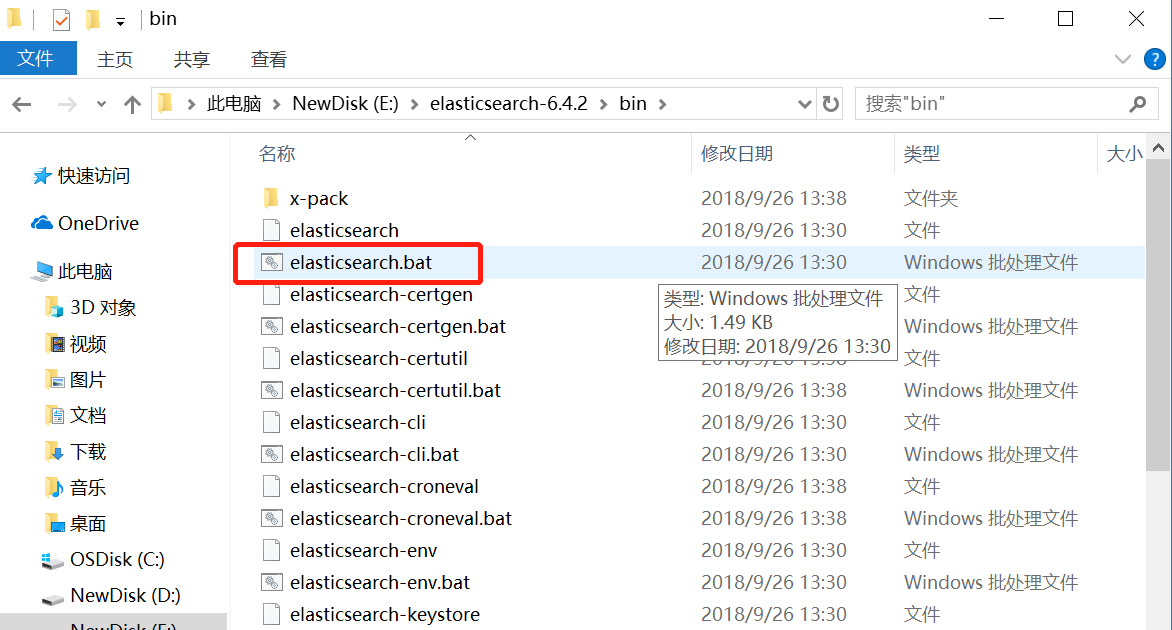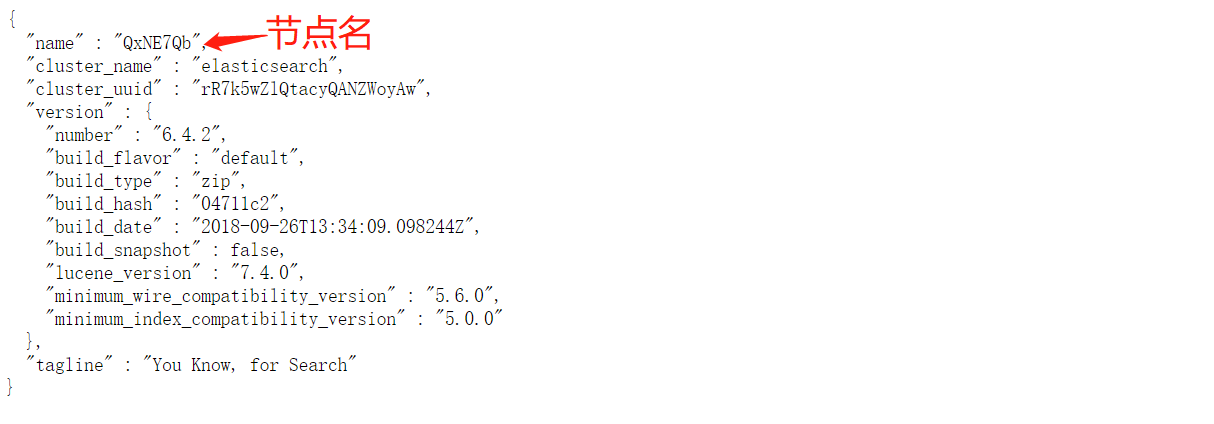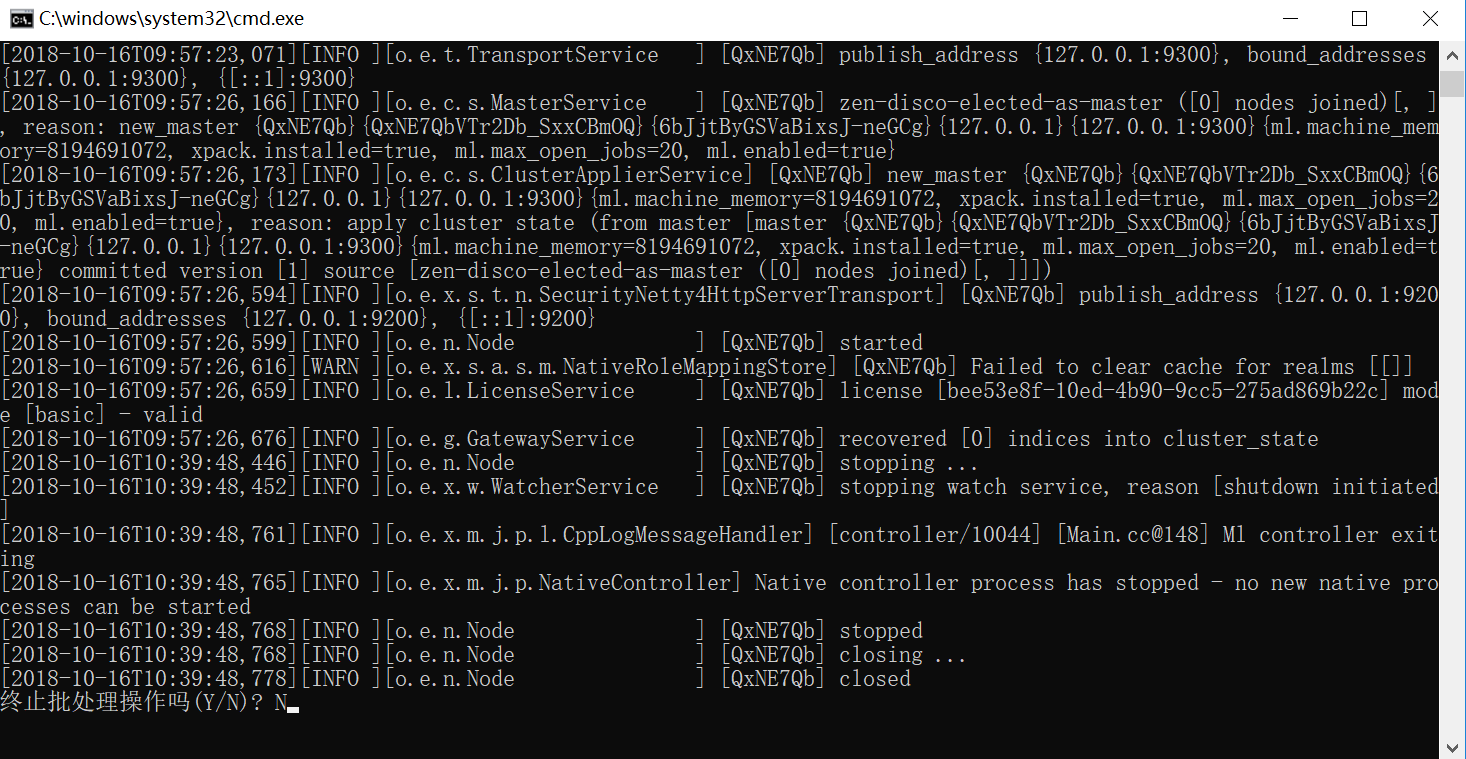This article aims to show you how to install ES in windows system and how to use its REST API to operate ES in windows system.
(1) Installation of ES under Windows
Make sure that the machine has java installed before installing es, preferably a newer version. I have 10 installed on my machine.
C:\>java -version java version "10" 2018-03-20 Java(TM) SE Runtime Environment 18.3 (build 10+46) Java HotSpot(TM) 64-Bit Server VM 18.3 (build 10+46, mixed mode)
Download address of es official website https://www.elastic.co/downloads/elasticsearch
After finding the corresponding version to download, extract it, find elasticsearch.bat and double-click to start it.


To view the following information after successful execution

At this point, the installation startup is over.
It can be turned off with Ctrl+c.

Now that we have a working node (and cluster), the next step is to understand how to communicate with it. Fortunately, Elastic search provides a very comprehensive and powerful REST API that allows you to interact with your cluster. On Windows, we use git bash to execute related commands, not under cmd (students who don't have it can install it).
(1) Operation Cluster
Here are a few things you can do with this API:
- Check the health status and various statistics of your clusters, nodes and indexes
-
//View cluster status $ curl 'localhost:9200/_cat/health?v' //Response data % Total % Received % Xferd Average Speed Time Time Time Current Dload Upload Total Spent Left Speed 0 0 0 0 0 0 0 0 --:--:-- --:--:-- 100 296 100 296 0 0 9548 0 --:--:-- --:--:-- --:--:-- 9548epoch timestamp cluster status node.tot al node.data shards pri relo init unassign pending_tasks max_tas k_wait_time active_shards_percent 1539669345 13:55:45 elasticsearch green 1 1 0 0 0 0 0 0 - 100.0% ————————————————————————————————————————————————————————————————————————————————————————— //Get the list of nodes in the node cluster $ curl 'localhost:9200/_cat/nodes?v' //Response data % Total % Received % Xferd Average Speed Time Time Time Current Dload Upload Total Spent Left Speed 100 175 100 175 0 0 5645 0 --:--:-- --:--:-- --:--:-- 5645ip percent ram.percent cpu load_1m load_5m load_15m node.role master name 127.0.0.1 38 67 2 mdi * QxN ————————————————————————————————————————————————————————————————————————————————————————— //List all indexes $ curl 'localhost:9200/_cat/indices?v' //Response data (since we haven't indexed yet, the index is empty here) % Total % Received % Xferd Average Speed Time Time Time Current Dload Upload Total Spent Left Speed 100 83 100 83 0 0 5533 0 --:--:-- --:--:-- --:--:-- 5533health status index uuid pri rep docs.count docs.deleted store.size pri.store.size - Manage your clusters, nodes, indexed data and metadata
- CRUD (Create, Read, Update and Delete) and Search for Your Index
-
//Create an index called myindices that pretty attaches to the end of the call to print out the JSON response in a beautiful form $ curl -XPUT 'localhost:9200/myindices?pretty' //Response data % Total % Received % Xferd Average Speed Time Time Time Current Dload Upload Total Spent Left Speed 100 85 100 85 0 0 38 0 0:00:02 0:00:02 --:--:-- 38{ "acknowledged" : true, "shards_acknowledged" : true, "index" : "myindices" } ————————————————————————————————————————————————————————————————————————————————————————— //Index a document error example $ curl -XPUT 'localhost:9200/myindices/sutdent/1?pretty' -d '{"name":"yuhua"}' //When you execute the above command, you will find that the following errors are reported because the corresponding parameters are not in the correct format. % Total % Received % Xferd Average Speed Time Time Time Current Dload Upload Total Spent Left Speed 100 125 100 109 100 16 7266 1066 --:--:-- --:--:-- --:--:-- 8333{ "error" : "Content-Type header [application/x-www-form-urlencoded] is not supported", "status" : 406 } //A good example of indexing a document. I tried http://as if I could add it or not. $ curl -H "Content-Type:application/json" -XPUT 'http://localhost:9200/myindices/student/1?pretty' -d '{"name":"yuhua"}' //Response data % Total % Received % Xferd Average Speed Time Time Time Current Dload Upload Total Spent Left Speed 100 242 100 226 100 16 965 68 --:--:-- --:--:-- --:--:-- 1034{ "_index" : "myindices", "_type" : "student", "_id" : "1", "_version" : 1, "result" : "created", "_shards" : { "total" : 2, "successful" : 1, "failed" : 0 }, "_seq_no" : 0, "_primary_term" : 1 } ————————————————————————————————————————————————————————————————————————————————————————— //Extracting indexed documents $ curl -XGET 'http://localhost:9200/myindices/student/1?pretty' //Response data % Total % Received % Xferd Average Speed Time Time Time Current Dload Upload Total Spent Left Speed 100 145 100 145 0 0 9062 0 --:--:-- --:--:-- --:--:-- 9062{ "_index" : "myindices", "_type" : "student", "_id" : "1", "_version" : 1, "found" : true, "_source" : { "name" : "yuhua" } } ————————————————————————————————————————————————————————————————————————————————————————— //Delete index $ curl -XDELETE 'http://localhost:9200/myindices?pretty' //Response data % Total % Received % Xferd Average Speed Time Time Time Current Dload Upload Total Spent Left Speed 0 0 0 0 0 0 0 0 --:--:-- 0:00:01 --:--:-- 0curl: (6) Could not resolve host: E 100 28 100 28 0 0 68 0 --:--:-- --:--:-- --:--:-- 68{ "acknowledged" : true } ————————————————————————————————————————————————————————————————————————————————————————— curl -X<REST Verb> <Node>:<Port>/<Index>/<Type>/<ID> //This REST access pattern is generally applicable to all API commands - Perform advanced query operations such as paging, sorting, filtering, scripting, faceting, aggregations, and many others
Or that old saying, if you want to use a good tool, you need to develop the habit of inquiring its documents and api s. It is very difficult to remember hundreds of ways by our own heads. Of course, it is not excluded that there are such extraordinary classmates. Below are two good materials, you can spare.
ES Authoritative Guide
https://es.xiaoleilu.com/010_Intro/25_Tutorial_Indexing.html
ES API document
https://endymecy.gitbooks.io/elasticsearch-guide-chinese/content/java-api/index-api.html
If you have any questions, you are welcome to interact with me. You can comment and leave a message. In the future, I will insist on updating at least one blog article every week. If you like, you can pay more attention to it.